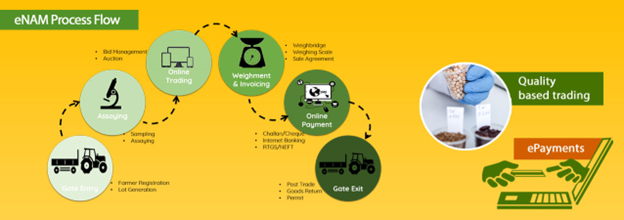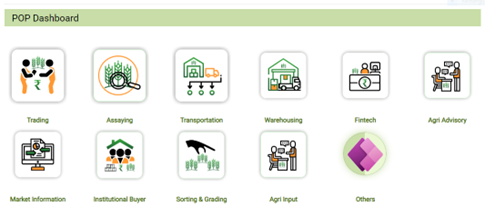About Enam: National Agriculture Market (Enam) is a pan-India electronic trading portal which networks the existing APMC mandis to create a unified national market for agricultural commodities. Small Farmers Agribusiness Consortium (SFAC) is the lead agency for implementing Enam under the aegis of Ministry of Agriculture and Farmers’ Welfare, Government of India.
-
- VISION: To promote uniformity in agriculture marketing by streamlining of procedures across the integrated markets, removing information asymmetry between buyers and sellers and promoting real time price discovery based on actual demand and supply.
- MISSION:Integration of APMCs across the country through a common online market platform to facilitate pan-India trade in agriculture commodities, providing better price discovery through transparent auction process based on quality of produce along with timely online payment.
MAIN OBJECTIVES OF THE SCHEME:
1. to integrate markets first at the level of the States and eventually across the country through a common online market platform, to facilitate pan – India trade in agricultural commodities;
2. to streamline marketing / transaction procedures and make them uniform across all markets to promote efficient functioning of the markets;
3. to promote better marketing opportunities for farmers / sellers through online access to more buyers / markets, removal of information asymmetry between farmer and trader, better and real-time price discovery based on actual demand and supply of agri-commodities, transparency in auction process, prices commensurate with quality of produce, online payment etc. that contribute to marketing efficiency;
6 New Commodities added on e-NAM (Total 221 Commodities): Included Food Grains/Cereals are Little Millet, Kodo Millet, Barnyard Millet, Browntop Millet, Proso Millet, Amaranth Seed
4. to establish quality assaying systems for quality assurance to promote informed bidding by buyers; and
5. to promote stable prices and availability of quality produce to consumers.

FEATURES:
-
- it is a Central Sector Scheme.
- Agri-Tech Infrastructure Fund (ATIF) forms the main source of funding.
- Small Farmers Agribuisness Consortium (SFAC) is the nodal implementing agency.
e-NAM Platform of Platforms (PoP): e-NAM integrates the platform of Service Providers as “Platform of Platforms” which includes:
-
- Composite Service Providers (Service Providers who provide holistic services for trading of agricultural produce including quality analysis, trading, payment systems and logistics)
- Logistics Service Provider, Quality Assurance Service Provider, Cleaning, Grading, Sorting & Packaging Service Provider, Warehousing Facility Service Provider, Agricultural Input Service Provider, Technology Enabled Finance & Insurance Service Provider
- Information Dissemination Portal (Advisory Services, crop forecasting, weather updates, capacity building for farmers etc.)
- Other platforms (e-commerce, international agri-business platforms, barter, private market platforms etc.).

BENEFITS:
-
- Transparent Online Trading.
- Real-Time Price Discovery.
- Better Price Realization for Farmers.
- Reduced Transaction Cost for Buyers.
- Stable Price and Availability to Consumers.
- Quality Certification, Warehousing and Logistics.
- More Efficient Supply Chain.
- Convenient e-Payment options.
- Error-Free Reporting of Transactions.
- Enhanced Accessibility to more APMCs.
PROGRESS:
-
- With more states opening up or facilitating trade of agricultural commodities on the government’s electronic – National Agriculture Market (e-NAM), trade on the digital wholesale platform crossed Rs 78,424 crore in FY24, up 5% on year.
- In the last five years, trade on the digital wholesale market run by the agriculture ministry has increased by 124% from 2019-20.
- There has also been a significant spurt in inter-mandi and inter-state trading of agri-commodities on the digital platform, which currently integrates 1389 mandis across 27 states.
- e-NAM is providing services to 18 million farmers with a trading volume of Rs 3 trillion, stated by Finance Minister.
- Inter-state trade on e-NAM increased from ₹1 crore during 2022-23 (April-December) to ₹40 crore in 2023-24 (April- December).
CONCLUSION:
The full realization of “One Nation One Market” goal depends on the complete operationalization of e-NAM across the country. Immediate actions are needed to enhance stakeholders’ understanding of the e-NAM concept and process, clarifying their roles and responsibilities through a well-developed, time-bound strategy encompassing publicity, awareness campaigns, and capacity building. Building trust among farmers and traders in this technology-based system is essential. Furthermore, the provision of necessary infrastructure, such as assaying facilities with skilled manpower and high-speed internet connectivity in all selected markets, is crucial for uninterrupted trading. The establishment of dispute resolution mechanisms at the APMC level for assaying, weighment, and e-payment matters is necessary. By addressing these considerations, e-NAM can revolutionize agricultural marketing in India, fostering efficient and transparent trade.
Spread the Word
